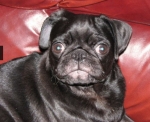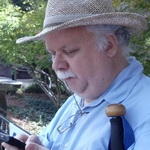I have done some reading, but still don't understand how pressure support works.
My ASV settings are
EPAP Min 8
EPAP Max 8
Max Pressure 20
PS min 4
PS Max 12
The readings on my pressure support for the last 7 days is 4.9.
Also, what is periodic breathing?
Thanks
Pressure Support- can anyone explain?
Pressure Support- can anyone explain?
_________________
| Mask: Wisp Nasal CPAP Mask with Headgear - Fit Pack |
| Additional Comments: PR System One Remstar BiPap Auto AS Advanced. |
Dog is my copilot
Re: Pressure Support- can anyone explain?
pressure support controls the difference between the IPAP and the EPAP
Re: Pressure Support- can anyone explain?
Per Respironics Encore Software glossary
Periodic Breathing is a Respironics data feature defined as a persistent waning and waxing breathing pattrn which repeats itself between 30 and 100 seconds. The nadir of the breathing pattern is characterized by at least a 40% reduction in airflow from an established baseline flow. The pattern must be present for several minutes before it can be identified as periodic breathing. No therapy adjustments are made in response to periodic breathing.
Cheyenne Stoke Respiration is a form of periodic breathing.
From the Wiki
Cheyne-Stokes respiration is an abnormal pattern of breathing characterized by progressively deeper and sometimes faster breathing, followed by a gradual decrease that results in a temporary stop in breathing called an apnea. The pattern repeats, with each cycle usually taking 30 seconds to 2 minutes. It is an oscillation of ventilation between apnea and hyperpnea with a crescendo-diminuendo pattern, and is associated with changing serum partial pressures of oxygen and carbon dioxide.
Cheyne-Stokes respiration and periodic breathing are the two regions on a spectrum of severity of oscillatory tidal volume. The distinction lies in what we observe happening at the trough of ventilation: if there is apnea, we describe it as Cheyne-Stokes respiration (since apnea is a prominent feature in their original description); if there is only hypopnea (abnormally small but not absent breaths) then we call it periodic breathing. Physiologically and mathematically, the phenomena are less different than they appear, because breaths that are smaller than the anatomical dead space do not actually ventilate the lung and so - from the point of view of gas concentrations in an alveolus - the nadir of hypopnea in periodic breathing may be indistinguishable from apnea.
These phenomena can occur during wakefulness or during sleep, where they are called the Central sleep apnea syndrome (CSAS).
System One calls lumps this together with Periodic breathing..
Periodic Breathing is a Respironics data feature defined as a persistent waning and waxing breathing pattrn which repeats itself between 30 and 100 seconds. The nadir of the breathing pattern is characterized by at least a 40% reduction in airflow from an established baseline flow. The pattern must be present for several minutes before it can be identified as periodic breathing. No therapy adjustments are made in response to periodic breathing.
Cheyenne Stoke Respiration is a form of periodic breathing.
From the Wiki
Cheyne-Stokes respiration is an abnormal pattern of breathing characterized by progressively deeper and sometimes faster breathing, followed by a gradual decrease that results in a temporary stop in breathing called an apnea. The pattern repeats, with each cycle usually taking 30 seconds to 2 minutes. It is an oscillation of ventilation between apnea and hyperpnea with a crescendo-diminuendo pattern, and is associated with changing serum partial pressures of oxygen and carbon dioxide.
Cheyne-Stokes respiration and periodic breathing are the two regions on a spectrum of severity of oscillatory tidal volume. The distinction lies in what we observe happening at the trough of ventilation: if there is apnea, we describe it as Cheyne-Stokes respiration (since apnea is a prominent feature in their original description); if there is only hypopnea (abnormally small but not absent breaths) then we call it periodic breathing. Physiologically and mathematically, the phenomena are less different than they appear, because breaths that are smaller than the anatomical dead space do not actually ventilate the lung and so - from the point of view of gas concentrations in an alveolus - the nadir of hypopnea in periodic breathing may be indistinguishable from apnea.
These phenomena can occur during wakefulness or during sleep, where they are called the Central sleep apnea syndrome (CSAS).
System One calls lumps this together with Periodic breathing..
_________________
| Machine: AirCurve™ 10 VAuto BiLevel Machine with HumidAir™ Heated Humidifier |
| Additional Comments: Mask Bleep Eclipse https://bleepsleep.com/the-eclipse/ |
I may have to RISE but I refuse to SHINE.
- BasementDwellingGeek
- Posts: 262
- Joined: Sat Nov 05, 2011 12:54 pm
- Location: N Billerica, MA, USA
- Contact:
Re: Pressure Support- can anyone explain?
the cpap machine indicated a PB event at 11:27:29,after about 3 minutes of this axing & waning breathing.
_________________
| Mask: Swift™ FX Nasal Pillow CPAP Mask with Headgear |
| Humidifier: S9™ Series H5i™ Heated Humidifier with Climate Control |
| Additional Comments: own home grown SW to make it all work together, SH too. |
bdg
(PR System One REMstar Pro CPAP Machine with C-Flex Plus and related humidifier as backup)
There are two types of people in this world. Those that can extrapolate from incomplete data
(PR System One REMstar Pro CPAP Machine with C-Flex Plus and related humidifier as backup)
There are two types of people in this world. Those that can extrapolate from incomplete data
Re: Pressure Support- can anyone explain?
Respironics machines flag Periodic Breathing. It may or may not indicate Cheyenne Stokes Respiration.
I have had some times where it looks like it could be real CSR and sometimes where it is fairly obvious it would not make CSR criteria but there is the "waxing and waning" effect shown.
Even if it were the real deal unless someone had excessive PB flags we don't worry about a few random PB flags that aren't horribly long.
I have a couple of examples already uploaded showing a couple of PB flagged events. One looks like it could be CSR and one doesn't. Most of the PB flags I ever saw didn't come close to real CSR.
Real CSR looks like this.

And one of mine that looks like sort of CSR

And one of mine that doesn't look like CSR...no flat line but there is obvious waxing and waning of the flow.

I have had some times where it looks like it could be real CSR and sometimes where it is fairly obvious it would not make CSR criteria but there is the "waxing and waning" effect shown.
Even if it were the real deal unless someone had excessive PB flags we don't worry about a few random PB flags that aren't horribly long.
I have a couple of examples already uploaded showing a couple of PB flagged events. One looks like it could be CSR and one doesn't. Most of the PB flags I ever saw didn't come close to real CSR.
Real CSR looks like this.

And one of mine that looks like sort of CSR

And one of mine that doesn't look like CSR...no flat line but there is obvious waxing and waning of the flow.

_________________
| Machine: AirCurve™ 10 VAuto BiLevel Machine with HumidAir™ Heated Humidifier |
| Additional Comments: Mask Bleep Eclipse https://bleepsleep.com/the-eclipse/ |
I may have to RISE but I refuse to SHINE.
- JohnBFisher
- Posts: 3821
- Joined: Wed Oct 14, 2009 6:33 am
Re: Pressure Support- can anyone explain?
First, Pugsy provided excellent answers - as usual. The only thing I might add is a little more explanation of how an ASV unit uses Pressure Support.Mary Z wrote:I have done some reading, but still don't understand how pressure support works.
My ASV settings are:The readings on my pressure support for the last 7 days is 4.9.EPAP Min 8
EPAP Max 8
Max Pressure 20
PS min 4
PS Max 12
Also, what is periodic breathing? ...
An ASV unit can address both the obstructive sleep apneas and the central sleep apneas.
To address the obstructive sleep apneas, it varies the EPAP (Exhalation Positive Airway Pressure) from EPAP min to EPAP max. In your case, Mary Z, it is the same value. I suspect that you did not have a lot of problems with obstructive events, so the single pressure did just fine at keeping your airway open.
To address the central sleep apnea events, the ASV unit varies the Pressure Support (PS) from PS min to PS max. This pressure is ADDED to the current EPAP value. In your case, it is added to 8. But if someone had a range (let's say it was from 8 to 12), then if the current EPAP value is at 10, the minimum IPAP value would be EPAP cur plus PS min (or in this case 10 + 4). So, the current EPAP is 10 and IPAP is 14. If a central apnea occurs, the ASV unit starts to ramp up the inhalation pressure (within just a few breaths) to EPAP cur plus PS max (or in this case 10 + 12). In this case, the current EPAP is 10 and the IPAP is 20. What? Shouldn't it be 10 + 12 or 22cm H2O. Well there's one more setting that sets the absolute maximum IPAP value. In your case that's Max Pressure that is set to 20. So, even though EPAP cur plus PS max is 22, the unit will not go beyond Max Pressure.
In your specific case, with EPAP min and EPAP max being 8, your IPAP min is 12 and IPAP max is 20.
To summarize the EPAP min and EPAP max help the ASV unit address the obstructive apnea. To address any central apneas the unit will increase the PS value up to PS max or Max Pressure (whichever is lower). This allows the unit to help us maintain our respiration .. even when we fail to do so.
Hope that helps you better understand your settings ...
_________________
| Mask: Quattro™ FX Full Face CPAP Mask with Headgear |
| Additional Comments: User of xPAP therapy for over 20 yrs. Resmed & Respironics ASV units with EEP=9cm-14cm H2O; PSmin=4cm H2O; PSmax=15cm H2O; Max=25cm H2O |
"I get up. I walk. I fall down. Meanwhile, I keep dancing” from Rabbi Hillel
"I wish to paint in such a manner as if I were photographing dreams." from Zdzisław Beksiński
"I wish to paint in such a manner as if I were photographing dreams." from Zdzisław Beksiński










